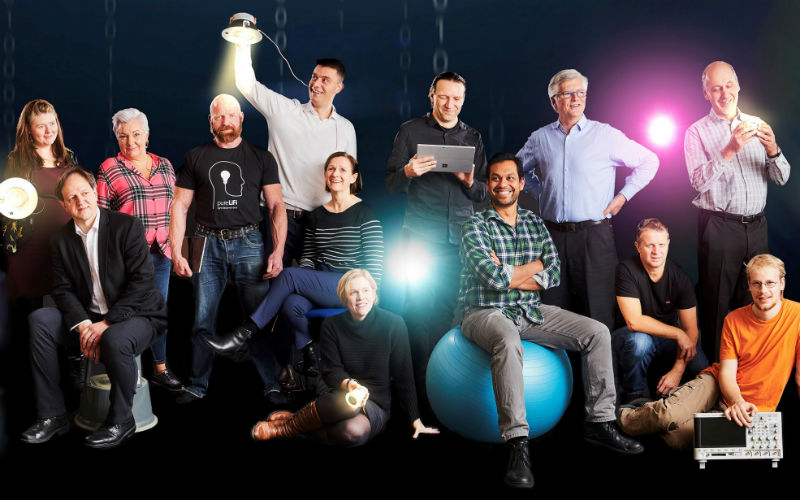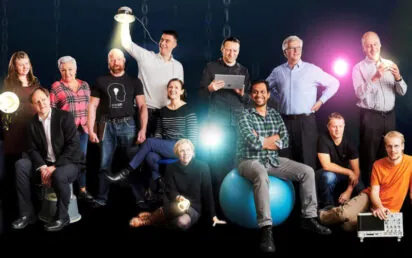Edinburgh firm pureLiFi, winner of our Scotland Tech 50 ranking for 2020, is a world leader in a technology which could become the ‘motorway for internet data’.
Founded by Prof. Harald Haas and Dr Mostafa Afgani as a spin–out of the University of Edinburgh, pureLiFi uses the light spectrum to send data rather than radio frequencies.
By making small adjustments in the intensity of light, it can deliver an internet connection with a bandwidth far beyond the capabilities of conventional wireless communications such as Wi-Fi.
With data traffic increasing exponentially every year and causing a ‘spectrum crunch’ headache, the potential for easing the burden on existing technologies is massive, says CEO Alistair Banham.
“The world’s reliance on the internet is growing exponentially,” he tells BusinessCloud. “In order to sustain the current level of bandwidth requirement we need to release more spectrum.
“Light has 1000x the spectrum of Radio Frequency. A simple way to compare LiFi and RF technology such as Wi-Fi and cellular is to think of them as light roads: LiFi is the Motorway and RF is a country road. You can simply push a lot more traffic through with light rather than radio.
“We’re not here to replace RF, which is a great technology; we’re here to complement it. LiFi will become one of the biggest – if not the biggest – bearer of data within future networks and systems.”
The company was founded in 2012, with funding from Scottish Enterprise, on the back of a TEDGlobal Talk where the technology was demonstrated in public for the first time – and Prof. Haas coined the term LiFi.
LiFi is already capable of gigabit connectivity but has the potential to reach tens of gigabits per second, according to Banham, who joined the firm in 2016. It also has major benefits when it comes to security and stability.
“With RF, you can get these little sniffer machines that can detect electromagnetic waves and show a footprint. Using the light spectrum, there’s no digital footprint: there’s no way of anyone capturing the data in that light signal,” explains the CEO.
“You don’t even know where it is. There’s a lot of talk about cyber security at the moment, which means people are coming to us to ask whether we have a solution to make them more secure.
“The quality of the connection is very good. With RF systems there can be quite a lot of interference: if you’re living in flats and there are Wi-Fi signals above you, below you and beside you, that starts to cause issues and the net impact is that the signal decays.
“RF is a big bubble. The more people get into the bubble, the more issues you have with the amount of data that each of you can receive and transmit. In a public area such as an airport, you might be desperate to send an important document to your boss but find it impossible to get on to the network; and if you do get on, you could be kicked off at any point.
“You don’t get that with our technology. Light doesn’t pass through walls, so you can’t jam the source. We also don’t steal bandwidth from the next access point: if you’re sitting under one light cone, and I’m next to you under my light, we’re both transmitting and receiving data. But if I happen to download a massive Netflix film, your bandwidth doesn’t get affected.”
In the smartphone of the future, you might select LiFi rather than Wi-Fi when sitting in a café. In your own home or other familiar locations, where you’ve set up protocols, the device will automatically connect when you enter the cone’s transmission zone. When you move outside of that cone, it immediately switches off.
Today pureLiFi has 200 deployments being evaluated in 20 countries across 20 different use-cases.
For example a partnership with Getac has seen LiFi incorporated into the manufacturer’s rugged tablets and PCs for the military, manufacturing and automotive industries. It is also working with Cisco.
“We have very good relationships with global OEM companies,” says Banham. “We’re going to provide LiFi components for the mass market through our light antenna devices which integrate into mobile devices.
“We still have a long way to go because when you are evolving a new technology, it’s not an overnight design; it takes quite a bit of time to embed, test and evaluate it, and make sure you’ve got the right use-cases.
“But we believe we’re over the early adopters now and the next few years are going to be extremely exciting for us. I would say that we’ll probably get pervasive with this technology in the next two, three, four years.
“COVID’s not helping because everything is slowing down, but we’re on the right trajectory.”
CEO Banham has more than 30 years’ experience in the semiconductor industry which could be crucial in bringing LiFi to the mass market.

CEO Alistair Banham
Following executive roles at the likes of Philips, Wolfson Microelectronics and ON Semiconductor – where he played a leading role in the spin-out from Motorola and subsequent IPO – he relished the opportunity to help build a new technology from the ground up.
“I took some time out for a couple of years. When I was approached about this opportunity, being very candid with you, I hadn’t even heard of LiFi,” he admitted. “The more I researched it, the more I loved looking at what this new technology could bring.
“If you’re in a start-up, you’re changing the light bulbs, helping in the lab, helping the team. It’s part of the fun. But in addition, because of the fortunate experience I have, having worked with some of those great companies, I can do the strategic stuff as well.
“It’s a great challenge working with a start–up and a bunch of really bright engineers to deliver this technology and make it pervasive and part of our DNA.”
Being based in Scotland is also a boon for pureLiFi, according to Banham.
“Scotland is renowned for being innovative in technology and leaving a legacy of great inventions,” he says. “It’s a hotbed of advanced research, knowledge and know-how of developing new tech.
“I see LiFi as another legacy technology which will become pervasive across the world. We are the forefront of the technology: people come to us because we drive it forward.
“Scotland is the centre of LiFi excellence. We see the world’s largest brands in lighting and mobile devices coming to Scotland for latest in LiFi innovation.”


